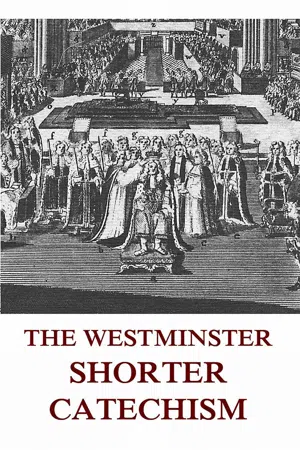
- 22 pages
- English
- ePUB (mobile friendly)
- Available on iOS & Android
About This Book
The Westminster Shorter Catechism (also known simply as the Shorter Catechism, hereinafter referred to as the WSC) was written in the 1640s by English and Scottish divines. The assembly also produced the Westminster Confession of Faith and the Westminster Larger Catechism. The three documents are considered by many Protestants to be the grandest doctrinal statements to come out of the English Reformation. Completed in 1647, it was presented to the Long Parliament on 14 April 1648.The purpose of the Shorter Catechism is to educate lay persons in matters of doctrine and belief. The WSC is in a simple question and answer format to facilitate memorization. Typically, parents and the church would use the shorter catechism to train their children in the ways of the Lord. New converts are also given the WSC as well as the Confession of Faith and Holy Scripture to study. Various denominations have used the Westminster Confession and Catechism to instruct their members. (courtesy of wikipedia.com)
Frequently asked questions
Information
The Reformation In England And Scotland
- The Anabaptists, who appeared in Germany and German Switzerland shortly after the appearance of Luther and Zwingli, wished to trace back their conception of the Church to Apostolic times. They denied the validity of the baptism of children, saw in the Blessed Eucharist merely a memorial ceremony, and wished to restore the Kingdom of God according to their own heretical and mystical views. Though attacked by the other Reformers, they won supporters in many lands. From them also issued the Mennonites, founded by Menno Simonis (d. 1561).
- The Schwenkfeldians were founded by Kaspar of Schwenkfeld, aulic councillor of Duke Frederick of Liegnitz and canon. At first he associated himself with Luther, but from 1525 he opposed the latter in his Christology, as well as in his conception of the Eucharist, and his doctrine of justification. Attacked by the German reformers, his followers were able to form but a few communities. The Schwenkfeldians still maintain themselves in North America.
- Sebastian Franck (1499-1542), a pure spiritualist, rejected every external form of ecclesiastical organization, and favoured a spiritual, invisible Church. He thus abstained from founding a separate community, and sought only to disseminate his ideas.
- The Socinians and other Anti-Trinitarians. Some individual members of the early Reformers attacked the fundamental doctrine of the Blessed Trinity, especially the Spaniard Miguel Servede (Servetus), whose writing, "De Trinitatis erroribus", printed in 1531, was burned by Calvin in Geneva in 1553. The chief founders of Anti-Trinitarianism were Laelius Socinus, teacher of jurisprudence at Siena, and his nephew, Faustus Socinus. Compelled to fly from their home, they maintained themselves in various parts, and founded special Socinian communities. Faustus disseminated his doctrine especially in Poland and Transylvania.
- Valentine Weigel (1533-1588) and Jacob Böhme (d. 1624), a shoemaker from Gorlitz, represented a mystical pantheism, teaching that the external revelation of God in the Bible could be recognized only through an internal light. Both found numerous disciples. Böhme's followers later received ther name of Rosenkreuzer, because it was widely supposed that they stood under the direction of a hidden guide named Rozenkreuz.
- The Pietists in Germany had as their leader Philip Jacob Spener (1635-1705). Pi...
Table of contents
- The Reformation In England And Scotland